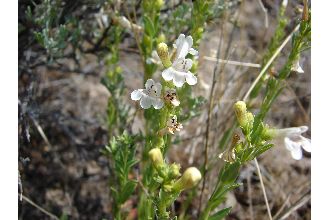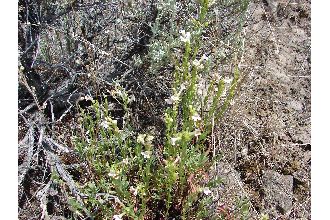Scabland Penstemon
Scientific Name: Penstemon deustus Douglas ex Lindl.

| General Information | |
|---|---|
| Usda Symbol | PEDE4 |
| Group | Dicot |
| Life Cycle | Perennial |
| Growth Habits | Forb/herbSubshrub, |
| Native Locations | PEDE4 |
Plant Guide
Alternate Names
Scabland penstemon
Uses
Hotrock penstemon is chiefly used as a forb component for wildlife habitat enhancement and restoration efforts. Its showy flowers attract numerous pollinators and other insects which provide a food source for birds and other vertebrates. This species is also commonly used in xeriscaping and other low-water-use landscaping. It is suited for roadside and other beautification plantings.
Status
Consult the PLANTS Web site and your State Department of Natural Resources for this plant’s current status (e.g. state noxious status).
Description
General: Figwort Family (Scrophulariaceae). Hotrock penstemon is a short-lived perennial forb 20 - 60 cm (8 - 24 inches) tall. Stems are glabrous, woody and much branched near the base. The leaves are bright green, glabrous, coarsely dentate-serrate, linear lanceolate to elliptic, 2 - 5 cm long and 6 - 20 mm wide. Flowers are nearly tubular, creamy white to tan, 8 - 15 mm long in loose whorls along the upper stem. Flowering season is from May to July. Seeds are very small with approximately 2,900,000 seeds per pound. Distribution: Hotrock penstemon is found in scattered populations in eastern Washington, southern Idaho, southwestern Montana and south through Oregon to the central Sierra Nevada in California, the northern 2/3 of Nevada, northwestern Utah and western Wyoming. Habitat: Hotrock penstemon inhabits dry rocky places, basalt flows, pressure ridges and cliffs and occasionally limestone outcrops in sagebrush, juniper and pinyon-juniper plant communities. Plants typically occur at elevations from 2600 to 8200 feet. Hotrock penstemon in natural habitat. Nancy Shaw, USDA Forest Service, Boise, ID
Adaptation
This species is adapted to well-drained loam to fine sandy loam soils with a pH range of 5.0 to 8.0. For xeriscaping and low water gardening, the species is recommended for use in USDA hardiness zones 6-8 in areas receiving 8 - 10 inches or more annual precipitation.
Management
When planted in a native reclamation mix, hotrock penstemon should be a minor component of the establishing plant community; therefore management should be based on other key species in the mixture. Grazing on seeded lands should be deferred for at least two growing seasons to allow for establishment.
Pests and Potential Problems
Impact from insect pests on penstemon seed production can be significant. Penstemon borer larva can infect the crown and upper root area of all penstemon species resulting in the loss of individual plants to entire fields. Presently, penstemon borers are known only from extreme southwestern Colorado. Penstemon clearwing (Penstemonia spp.) attacks multiple Penstemon species. The larvae feed within the stems of the crown and lower above ground portions of the plant. A pheromone is available for monitoring of adults. Other potentially significant pests include Lygus bugs and raceme-boring moths. Hotrock penstemon is also susceptible to soil-borne fusarium and rhizoctonia root rot, which can be severe in poorly drained loam and clay-textured soils.
Seed and Plant Production
Plant Production
Plant Production
Fields for seed production can be established by transplanting greenhouse grown containerized stock or from direct seeding. Direct seeding should take place in the fall to allow for natural stratification of the seed. Greenhouse materials can be established by seeding into cones or flats in winter for natural stratification or by stratifying the seed for 8 - 12 weeks in cold/moist conditions. Prechilling requirements can be reduced with a liquid smoke treatment. Germination can also be enhanced by watering with a weak solution of giberellic acid (250 ppm) though treated seedlings appear to be less vigorous than non-treated. Seed should be planted to a depth of 0 - 6 mm (0 - 0.25 in). Chemical weed control in seed production fields of forbs is a challenge and preliminary work is only getting underway. In herbicide tolerance screening trials conducted at the Malheur Experiment Station in Oregon, hotrock penstemon had good tolerance (based on seed yields) to post emergence applications of Select (Clethodim), Outlook (Dimethenamid-P), and Prowl (Pendimethalin). Hotrock penstemon showed sensitivity to post emergence applications of Buctril (bromoxynil octanoate), Goal (oxyfluorfen), Caparol (Prmetryn) and Lorox (Linuron). Considerable efforts to register herbicides for use on native forb seed production will be required. Penstemon seedlings grown in weed barrier fabric for seed production. Derek Tilley, USDA NRCS PMC, Aberdeen, ID Because of the limited number of available herbicides that can be used on broadleaf forbs, planting into weed-barrier fabric (pictured above) is a viable alternative to control weeds in forb seed production fields. Holes should be three to four inches in diameter at 9 - 18 inch spacing. Successful pollination is essential for commercial seed production of hotrock penstemon. Bees and wasps that have been observed pollinating hotrock penstemon include sweat bees, bumble bees, honey bees and leafcutter bees. The flowers bloom from May to July. The seed is mature when the capsule turns brown and begins to open. This typically occurs 5 - 8 weeks after flowering. The brown to black seed persists in the capsule for several weeks. Seed harvest can be accomplished by hand or by direct combining. Harvest should occur when the stems and capsules begin to dry and open. Seed can be cleaned with a small clipper or air-screen cleaner. Seed yields range from 20 - 50 lb/ac (22 – 56 kg/ha). The seed capsules stay closed for some time after maturation, so it is not essential to harvest seed immediately. Cultivars, Improved, and Selected Materials (and area of origin) There are currently no releases of hotrock penstemon. Wildland harvested seed is available through commercial sources.
References
Chicago Botanic Garden’s Restoration Research in the Great Basin Staff. Penstemon Pollinators. URL: http://cbscience.org/great_basin/pollinators_penstemon.htm (accessed 17 Dec. 2008).
Propagation
protocol for production of container Penstemon deustus plants, USDA FS – Rocky Mountain Research Station, Boise, Idaho, In: Native Plant Network, URL: http://www,nativeplantnetwork,org (accessed 16 Dec 2008), Moscow (ID): University of Idaho, College of Natural Resources, Forest Research Nursery, Las Pilatas Nursery, 2008, www,laspilitas,com/plants/486,htm (accessed 16 Dec 2008), San Margarita, CA, Shaw, N,, Walker, S,, Jensen, S,, Thompson, T, and A, DeBolt, 2003, Native plant material development and seed and seeding technology for native Great Basin forbs and grasses, In: Great Basin Native Plant Selection and Increase Project FY03 Progress Report, Shock, C,, Ishida, J, and E, Feibert, 2008, Identification of herbicides for use in native forb seed production, In: Great Basin Native Plant Selection and Increase Project FY07 Progress Report, UC/JEPS: Jepson Manual treatment for Penstemon deustus, URL: http://ucjeps,berkeley,edu?cgi-bin/get_JM_treatment,pl?Penstmon+deustus (accessed 16 Dec 2008) USDA Natural Resources Conservation Service, 2008, The PLANTS database, version 3,5, URL: http://plants,usda,gov (accessed 15 Dec 2008), Baton Rouge, LA, National Plant Data Center, Use soil moisture sensors to measure the soil moisture of Scabland Penstemon., Western Colorado Extension: Native Plant Seed Production, 2008, http://wsprod,colostate, edu/cwis487/wci/seed_production,html, (accessed 16 Dec 2008),
Prepared By
Loren St. John, USDA NRCS Plant Materials Center, Aberdeen, ID Dan Ogle, USDA NRCS Idaho State Office, Boise, ID Nancy L. Shaw, USDA Forest Service, Rocky Mountain Research Station, Boise, ID Species Coordinator Dan Ogle, USDA NRCS Idaho State Office, Boise, ID Edited: 121708LWS; 010709DGO; 010709NLS; 090112 jsp For more information about this and other plants, please contact your local NRCS field office or Conservation District, and visit the PLANTS Web site<http://plants.usda.gov> or the Plant Materials Program Web site <http://Plant-Materials.nrcs.usda.gov> The U.S. Department of Agriculture (USDA) prohibits discrimination in all its programs and activities on the basis of race, color, national origin, sex, religion, age, disability, political beliefs, sexual orientation, and marital or family status. (Not all prohibited bases apply to all programs.) Persons with disabilities who require alternative means for communication of program information (Braille, large print, audiotape, etc.) should contact USDA's TARGET Center at 202-720-2600 (voice and TDD). To file a complaint of discrimination write USDA, Director, Office of Civil Rights, Room 326-W, Whitten Building, 14th and Independence Avenue, SW, Washington, DC 20250-9410 or call 202-720-5964 (voice or TDD). USDA is an equal opportunity provider and employer. Read about Civil Rights at the Natural Resources
Plant Traits
Growth Requirements
| Temperature, Minimum (°F) | -33 |
|---|---|
| Adapted to Coarse Textured Soils | Yes |
| Adapted to Fine Textured Soils | No |
| Adapted to Medium Textured Soils | Yes |
| Anaerobic Tolerance | None |
| CaCO3 Tolerance | Medium |
| Cold Stratification Required | Yes |
| Drought Tolerance | High |
| Fertility Requirement | Low |
| Fire Tolerance | Medium |
| Frost Free Days, Minimum | 100 |
| Hedge Tolerance | None |
| Moisture Use | Low |
| pH, Maximum | 8.0 |
| pH, Minimum | 6.0 |
| Precipitation, Maximum | 18 |
| Precipitation, Minimum | 10 |
| Root Depth, Minimum (inches) | 14 |
| Salinity Tolerance | Low |
| Shade Tolerance | Intolerant |
Morphology/Physiology
| After Harvest Regrowth Rate | Slow |
|---|---|
| Toxicity | None |
| Shape and Orientation | Semi-Erect |
| Nitrogen Fixation | None |
| Resprout Ability | No |
| Active Growth Period | Spring and Summer |
| Bloat | None |
| C:N Ratio | Medium |
| Coppice Potential | No |
| Fall Conspicuous | No |
| Fire Resistant | No |
| Flower Color | Yellow |
| Flower Conspicuous | Yes |
| Foliage Color | Green |
| Foliage Porosity Summer | Dense |
| Foliage Texture | Coarse |
| Low Growing Grass | No |
| Lifespan | Long |
| Leaf Retention | No |
| Known Allelopath | No |
| Height, Mature (feet) | 2.0 |
| Growth Rate | Moderate |
| Growth Form | Multiple Stem |
| Fruit/Seed Conspicuous | No |
| Fruit/Seed Color | Brown |
| Foliage Porosity Winter | Porous |
Reproduction
| Vegetative Spread Rate | None |
|---|---|
| Small Grain | No |
| Seedling Vigor | Medium |
| Fruit/Seed Period Begin | Summer |
| Seed Spread Rate | Moderate |
| Seed per Pound | 400000 |
| Propagated by Tubers | No |
| Propagated by Sprigs | No |
| Propagated by Sod | No |
| Propagated by Seed | Yes |
| Propagated by Corm | No |
| Propagated by Container | No |
| Propagated by Bulb | No |
| Propagated by Bare Root | No |
| Fruit/Seed Persistence | No |
| Fruit/Seed Period End | Fall |
| Fruit/Seed Abundance | High |
| Commercial Availability | Contracting Only |
| Bloom Period | Late Spring |
| Propagated by Cuttings | No |
Suitability/Use
| Veneer Product | No |
|---|---|
| Pulpwood Product | No |
| Post Product | No |
| Palatable Human | No |
| Nursery Stock Product | No |
| Naval Store Product | No |
| Lumber Product | No |
| Fodder Product | No |
| Christmas Tree Product | No |
| Berry/Nut/Seed Product | No |

